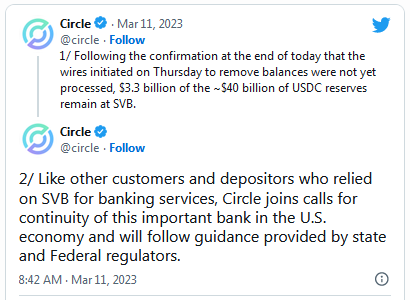After hitting an all-time low of around $0.8774 on Saturday, USD Coin quickly started recovering, surging to above $0.91.
The catastrophic collapse of Silicon Valley Bank, one of the largest lenders in the US, has sent shockwaves across financial markets, delivering massive losses to some of the bank’s most prominent clients. While venture capital firms and tech startups were most severely affected, numerous crypto companies were also affected and disclosed their exposure to the bank.
Circle, the issuer of the world’s second-largest stablecoin USDC, has revealed that it has $3.3 billion in an account maintained by Silicon Valley Bank. Following the revelation, USDC was hit with a wave of redemptions as concerns around reserves mounted, leading to USDC losing its peg to the US Dollar.
However, it should be worth noting that Circle holds most of its reserves in US Treasury Bills, managed by BlackRock. Many experts have suggested that the USDC will likely recover soon and retain its peg to the dollar.
Investors Concerned About Health of US Banking Sector as Two Banks Collapse in 48 Hours
It has been a tumultuous week for the American financial system. In 48 hours, the banking sector witnessed the collapse of two major banks: Silicon Valley Bank and Silvergate Bank.
SVB Financial Group, one of the most popular lenders to Silicon Valley tech and growth startups, failed on March 10, falling into the hands of the Federal Deposit Insurance Corporation (FDIC). On Friday, the federal agency took control of the bank and created the Deposit Insurance National Bank of Santa Clara, which now holds the insured deposits from SVB. The federal agency said in a press release Friday,
“Silicon Valley Bank, Santa Clara, California, was closed today by the California Department of Financial Protection and Innovation, which appointed the Federal Deposit Insurance Corporation as receiver,”
The swift collapse of Silicon Valley Bank came just two days after crypto-friendly bank Silvergate collapsed. As reported, Silvergate Bank’s parent company, Silvergate Capital (NYSE:SI), announced Wednesday that it has decided to wind down its operations and liquidate its subsidiary.
Silvergate was among the lenders hit hardest by the fall of FTX in November last year. The California-based bank suffered a run following the collapse of FTX and had to sell $5.2 billion of debt securities it was holding on its balance sheet at a significant loss to cover around $8.1 billion in user withdrawals.
The broader banking sector continues to take a hit as investors digest the recent collapse of two major banks. The aggravating user sentiment has seen the shares of another crypto-friendly, Signature Bank (NASDAQ:SBNY), go downhill. The bank’s shares were down nearly 23% on Friday and more than 37% since the start of the week.
Circle Reveals $3.3 Billion Exposure to SVB
Although venture capital firms and tech startups were most severely affected by the collapse of Silicon Valley Bank, some major crypto companies have also revealed exposure to the bank. Circle is one such company with billions stuck in the now-collapsed lender.
In a Friday tweet, the company said it has $3.3 billion of its $40 billion USDC reserves at the collapsed lender. The company added that it made wire transfer requests on Thursday, but they were not completed by the end of Friday. It said:
“Following the confirmation at the end of today that the wires initiated on Thursday to remove balances were not yet processed, $3.3 billion of the ~$40 billion of USDC reserves remain at SVB.”

Following the revelation, USDC was hit with redemptions as concerns around the stablecoin’s reserve increased. According to blockchain analysis firm Nansen, the stablecoin burned some $2.34 billion of USDC on Friday, taking out the tokens from circulation as investors redeemed dollars.
Binance, the world’s largest cryptocurrency exchange, also announced that it had suspended the auto-conversion of USDC to BUSD due to current market conditions, “specifically related to high inflows & the increasing burden to support the conversion,” the platform said in a late Friday tweet.
Subsequently, traders started moving out of USDC, which put some pressure on the stablecoin’s dollar peg. According to data by CoinMarketCap, the stablecoin’s price, which is supposed to be pegged to $1, slid to an all-time low of around $0.8774 on Saturday.
However, the stablecoin’s price has since trimmed some losses. Currently, USDC is trading at around $0.919, down by about 8% over the past day.
***
Disclaimer: Neither the author, Ruholamin Haqshanas, nor this website, The Tokenist, provide financial advice. Please consult our website policy prior to making financial decisions.
This article was originally published on The Tokenist. Check out The Tokenist’s free newsletter, Five Minute Finance, for weekly analysis of the biggest trends in finance and technology.
Which stock to consider in your next trade?
AI computing powers are changing the Canadian stock market. Investing.com’s ProPicks AI are winning stock portfolios chosen by our advanced AI for Canada, the US, and other exciting markets around the globe. Our top strategy, Tech Titans, nearly doubled the S&P 500 in 2024 - one of the most bullish years in history. And Beat the TSX, designed for broad market exposure, is showing +878% gains with 10 years’ back-tested performance. Which Canadian stock will be the next to soar?
Unlock ProPicks AI